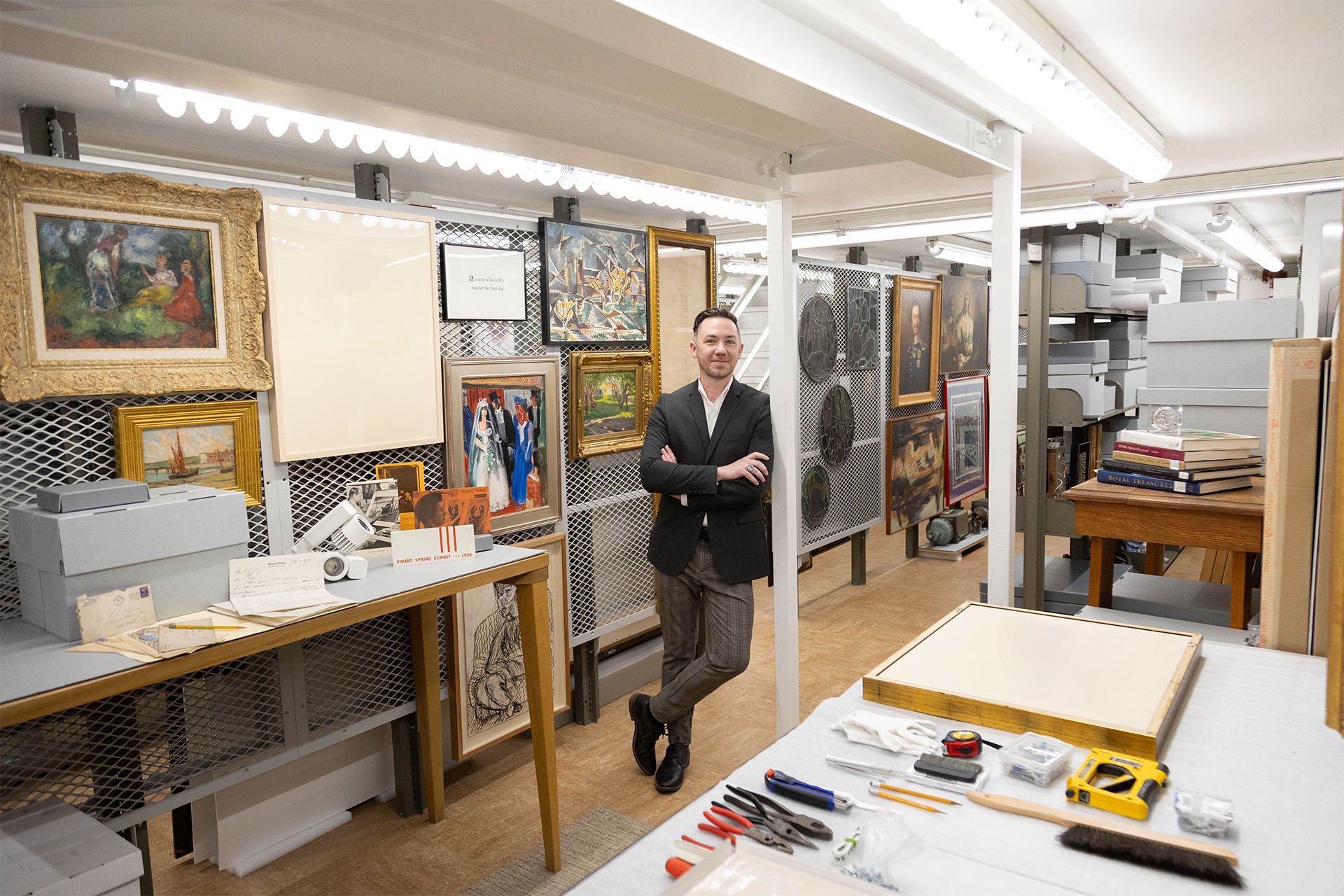
Office Space
By Morgan Paris
If you attended Saint Vincent prior to the start of the Library Renovation Project, chances are good you unknowingly spent some time in Andy Julo’s office—and the art storage area. Attracted to art since childhood, Julo got into art to be a maker, and while predominantly a steward of art at the moment, on the weekends, he works on his own craft, creating relief prints and cyanotypes (some of which are now on display in the Kansas City International Airport), which he now exhibits regionally. But, ever humble, he’s more apt to talk about the pieces that have found sanctuary and rest in the College’s library. The Saint Vincent Art & Heritage Collections boasts more than 5,000 objects, most of which are in the art storage area—formerly the upstairs stacks—which still has a faint biblichor scent. The director and curator for the Verostko Center of the Arts, Julo spends a great deal of his time in the art storage area, being curator in every sense of the word. As many understand the word “curator,” Julo does collect and organize pieces. But, “curator” comes from the Latin curare, which means “to take care of,” and Julo’s just as much of a caretaker of the objects in the collection as he is collector. Julo describes the art storage area as an “aha space,” a place that is sometimes a special stop on a tour for guests of the gallery, not only because it is visually interesting, but also because there’s the opportunity to see objects from different times that were never really intended to all be in the same space. This makes time travelers out of the gallery’s guests—and now, too, the readers of 1846.
-

Adjustable Lighting
When the Verostko Center was being designed, great care was made to select lighting that was both flexible and with conservation in mind. When artwork is shown inside our galleries, these LED fixtures assist in the care of sensitive works.
-

“No man is his craft’s master the first day.”
While studying commercial illustration at the Art Institute of Pittsburgh, Roman Verostko, C’55, S’59, H’21, learned hand lettering. This sign, created by Roman, from 1948 describes a maxim from which I source great comfort.
-

An Archive for Art
The Verostko Center maintains a growing repository of archival materials on artists whose work is held by Saint Vincent, printed collateral from exhibitions hosted on campus since the late 1940s, and documentation related to the former Saint Vincent Monastic Museum.
-

Archival Boxes
Prior to relocating the Saint Vincent Art & Heritage Collections to the Verostko Center in 2019, the College received a Preservation Assistance Grant from the National Endowment for the Humanities. We were able to acquire a variety of archival packaging supplies that allow us to care for fragile items.
-

Pitassi Archive File
Beginning in 1926, Angelo Leopardo Pitassi operated a stained-glass atelier in Pittsburgh’s East End, specializing in medieval-revival glass. Thanks to the generosity of the artist’s granddaughter, Nancy Ellis, Saint Vincent preserves correspondence between the Studio and its clients along with over 600 design schematics. The Pitassi Studio Archive is currently being digitized by Jonah Weaver, C 27.
-

Saint Benedict Medallion
After graduating from Saint John’s University (Collegeville, Minnesota) in 2009, I participated in a year of service with the Benedictine Volunteer Corps. This medallion portraying St. Benedict in the cave was one of the very special gifts I received at the end of my time serving at Il Monastero di San Benedetto in Subiaco, Italy.
-

Books gifted by Craig Felton, Ph.D.
Through the generosity of Craig McFadyen Felton, Ph.D., C’61, Professor Emeritus of Art at Smith College (Northampton, Massachusetts), Saint Vincent is home to an impressive collection of 3,000+ reference texts concerning the history of art and architecture with special emphasis given to Early Modern Europe. I frequently rely on Dr. Felton’s donation to conduct research.
-

Tools for Framing
Acidic materials used to frame works on paper shorten their lifespan. I often enlist the Center’s student interns to assist with unframing and reframing these works.

